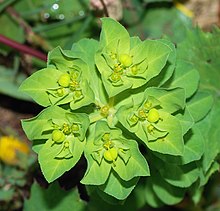Monadenium
| Euphorbia | |
|---|---|
 |
|
| Euphorbia cf. serrata' | |
| Scientific classification | |
| Kingdom: | Plantae |
| (unranked): | Angiosperms |
| (unranked): | Eudicots |
| (unranked): | Rosids |
| Order: | Malpighiales |
| Family: | Euphorbiaceae |
| Subfamily: | Euphorbioideae |
| Tribe: | Euphorbieae |
| Subtribe: |
Euphorbiinae Griseb. |
| Genus: |
Euphorbia L. |
| Type species | |
|
Euphorbia antiquorum L. |
|
| Subgenera | |
| Diversity | |
| c. 2008 species | |
| Synonyms | |
|
Chamaesyce |
|
Chamaesyce
Esula
Euphorbia
Rhizanthium
and see below
Chamaesyce
Elaeophorbia
Endadenium
Monadenium
Synadenium
Pedilanthus
Euphorbia is a very large and diverse genus of flowering plants, commonly called spurge, in the spurge family (Euphorbiaceae). "Euphorbia" is sometimes used in ordinary English to collectively refer to all members of Euphorbiaceae (in deference to the type genus), not just to members of the genus. Some euphorbias are commercially widely available, such as poinsettias at Christmas. Some are commonly cultivated as ornamentals, or collected and highly valued for the aesthetic appearance of their unique floral structures, such as the crown of thorns plant. Euphorbias from the deserts of Southern Africa and Madagascar have evolved physical characteristics and forms similar to cacti of North and South America, so they (along with various other kinds of plants) are often incorrectly referred to as "cacti". Some are used as ornamentals in landscaping, because of beautiful or striking overall forms, and drought and heat tolerance.
Euphorbias range from tiny annual plants to large and long-lived trees. The genus has over or about 2,000 members, making it one of the largest genera of flowering plants. It also has one of the largest ranges of chromosome counts, along with Rumex and Senecio.Euphorbia antiquorum is the type species for the genus Euphorbia. It was first described by Carl Linnaeus in 1753 in Species Plantarum.
...
Wikipedia
